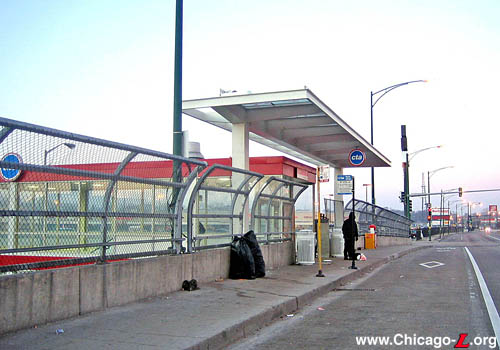
The entrance to the
renovated 87th station is seen looking west on December 24,
2006. Improvements to the entrance include refurbishment of
the structure, new paint, a new "storefront" enclosing the
entranceway with doors and windows, a new "eyebrow canopy"
over the entrance to protect waiting bus passengers, and
identification signage. For a larger view, click
here.
(Photo by Graham
Garfield)
|
87th
(8700S/1W)
87th Street and Dan Ryan
Expressway, Chatham
Service
Notes:

|
Red Line: Dan Ryan |

|
Accessible
Station |

|
Owl
Service |
Quick Facts:
Address: 15 W. 87th
Street
Established: September 28, 1969
Original Line: West-South Route, Dan Ryan branch
Previous Names: none
|
Skip-Stop Type:
|

|
Station
(1969)
|

|
Station
(1969-1993)
|
Rebuilt: 2005-06 (renovation), 2013 (refurbished, elevator added)
Status: In Use
History:
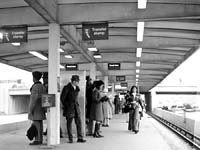
This 1973 view of the 87th
station platform looking north shows the station a few years
after opening but still in as-built condition. Note the
transfer stamp machine in the foreground; the Dan Ryan and
Kennedy stations had special machines with a casing designed
to harmonize with the stations' modern architecture. For a
larger view, click here.
(CTA Photo, Graham Garfield Collection)
|
The design of 87th and the other eight stations of the Dan Ryan line
were carried out by Skidmore, Owings & Merrill under the
direction of Myron Goldsmith, who developed a modern, functional form
in the late International style popular at the time. Improved
visibility and security, ease of cleaning and more comfortable
working conditions for CTA employee were design goals. Skidmore took the Kennedy-Dan Ryan
("KDR") project in a unique direction, designing all aspects of the
new lines to harmonize in both shapes and materials. All windbreaks,
dividers, and ticket booths were stainless steel. The supports of the
transparent platform canopies and the structures of the station
enclosures are white-painted steel frames, and the enclosures
themselves are glass. The formal and functional criteria were
expressed in several ways: open, uncluttered, brightly lit interior
spaces; durability, safety, maximum efficiency of movement; lightness
and purity of structure. The shape of everything, from the buildings
to the agents' booths, to the trashcans, followed together into a
seamless design philosophy, which perfectly captured the boxy, purely
functional International Modern style for which Skidmore is so well
known.
The commemorative brochure published for the event describes the
stations this way:
"Nine stations serve the Dan Ryan Line...
Wide visibility and a high level of illumination are
characteristic features in all areas. Fare collection equipment
and turnstiles are stainless steel and... escalators supplement
stairs for movement between station levels. Stations in the
expressway medians are constructed of steel and glass providing
maximum visibility from adjacent streets and highways. The
boarding platforms are long enough to accommodate 8-car trains...
Steel framed canopies of translucent plastic [extend]
beyond the center line of the tracks. Self-service infrared
radiant heaters are located at windbreaks on the
platforms."
87th Street has a small fare control area on the north end of the
island platform with stairs and an escalator leading to the street.
In terms of interior arrangement and design for the passenger,
Skidmore generally followed the edict of modernist pioneer Mies van
der Rohe that ‚ "less is more." Except for at a few locations
(most notably 95th Street terminal), there
were no concessions provided for passengers. Air conditioning and a
compact washroom with a toilet were provided in the agents' booths.
Restrooms were for employees only, though payphones were provided.
Stainless steel turnstiles, now an industry standard, were first used
here. The amenities and traffic circulation fit with the
architectural design of the station: efficient but purely functional.
Stations were designed with wide walkways and no blind corners, with
turnstiles and agents booths arranged for maximum queuing and
circulation effectiveness.
The stations' design even formed a harmony with the 150 rapid
transit cars that were ordered to serve the new Kennedy
and Dan Ryan lines,
which used the same design philosophies and basic shapes, and an
entirely new system of signage with a redesigned typeface and clean
graphic style (still used by CTA today, in a modified form), making a fully integrated design
throughout the entire project.
Stations were spaced at between half-mile and one-mile intervals,
reflecting an increasing spacing of stations prominent in the postwar
period, with bus lines acting as feeders to the rapid transit line.
The Dan Ryan and
Kennedy stations
were also set up to allow Pay On Train operation, though without all
of the complicated gates and rearrangement built into the Congress
stations. The translucent skin of the headhouse exteriors made this
type of operation more safe than before, though not necessarily
making it more aesthetically desirable for the customer. The result
was a utilitarian white steel and glass station that is functional
but not particularly ornate.
Dan Ryan Red Line
Rehabilitation Project
With few major improvements (though with a lot of patching) over
its thirty year life, by the early 21st century the Dan
Ryan Line was in need of a major overhaul. On April 3, 2003, the
Chicago Transit Board approved a $4.5 million contract to renovate
the 69th and 95/Dan
Ryan bus bridges as well as the bus turnaround at 95th Street,
signaling the beginning of the rehabilitation of the Dan Ryan branch
of the Red Line. The Dan Ryan renovation project entailed upgrading
the infrastructure of the line, including improving power reliability
and delivery of that power, and providing station improvements to the
seven stations on the branch north of the terminal.

Renovation work underway,
the original terrazzo flooring has been removed in this view
looking south at 87th on September 1, 2005. The contractor
has used orange spray paint to identify area for customers
to be careful during construction. The old station name
signs from the original, removed windbreaks have been hung
from the canopy with steel cables to provide temporary
station identification during construction. For a larger
view, click here.
(Photo by Graham Garfield)
|
On October 7, 2003, the Chicago Transit Board approved a $192.5
million contract to rehabilitate the Dan Ryan branch, with
Kiewit/Reyes, AJV (A Joint Venture) awarded the construction contract
as part of a competitive bid process. The total cost of the Dan Ryan
rehabilitation program was to be $282.6 million.
The project was executed in three phases. During the first phase
of the project, which extended from March 2004 to May 2005,
CTA replaced crossover track,
installed a temporary signal system to support the track work and
began third rail replacement from Cermak-Chinatown
to 95th. As part of Phase II, which ran
through early 2006, the CTA constructed two new substations and upgraded two existing
substations, installed a permanent signal system and replaced third
rail.
Phase III improvements, which began at the end of June 2005,
consisted primarily of station renovations. Work at the seven
stations located between Sox-35th and
87th included refurbishing platform canopies, architectural
components, escalators, the existing station house, and new platform
floor finishes, enhanced lighting, new customer assistant kiosks and
improved signs. Eight escalators along the branch were replaced and
new elevators were installed at 47th and
69th, making those stations accessible
to customers with disabilities. There were also enhancements to
improve bus connections, such as curb cuts, canopies over station
entrances and improved lighting on the approach to each station. At
87th, a new station entrance was added on the north side of 87th
Street.
87th station remained open throughout the
renovation project. Much of the work was done under single track
operations during midday, owl, and other off-peak hours to allow
contractors Kiewit/Reyes, Aldridge Electric, and others to undertake
renovation work. On many days, it was also common for half of the
platform at a time to be taken out of service at certain stations
during owl hours to provide unobstructed access to the contractors.
During some periods, trains in excess of four cars in length were
prohibited from stopping at certain stations also to provide
contractor access.
Preparatory work began in June 2005 and continued
in August as Kiewit began removing the old plexiglas canopy roof
"bubbles" so that the canopy structure could be refurbished, leaving
the canopy structural framework but little actual protection except
for small a area the platform where a tarpaulin had been stretched
over a small portion of the canopy to provide a moderate level of
protection from inclement weather. By the end of 2005, work was
undertaken to refurbish the canopy structure.
Work also began on removing the original terrazzo
platform flooring so that the new concrete floor could be installed.
By the end of August 2005, all of the terrazzo had been removed,
leaving only the rough under-flooring, ready for the installation of
the new concrete flooring. The old, original stainless steel
windbreaks had also been removed. The station name signs from in the
windbreaks were temporarily hung from the canopy using steel cables
to provide station identification. The escalator from street-level to
the platform had also been removed by this time.
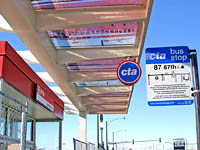
This December 8, 2006 photos
shows a myriad of CTA graphics, from left to right: a
standard "L" station entrance sign, the decorative art glass
in the canopy featuring PCC streetcars, CTA logo station
"identifier", and a bus stop sign for the #87 87th bus. For
a larger view, click here.
(Photo by Victor
Ramirez)
|
87th's new concrete platform flooring was completed in mid-September
2005. Bases and supports for new steel windbreaks were set in the new
platform flooring; the framework for the new enclosures installed by
the end of 2005. In the meantime, temporary wooden windbreaks were
installed to provide some shielding from the winter winds. By the end
of 2005, the original agents' booth had been removed and the fare
controls had been moved to allow work to continue in the fare control
area.
Work continued at 87th throughout Spring 2006. The second of two
"linecuts" was performed over Memorial Day 2006 weekend, when service
was temporarily suspended in both directions between 95th/Dan
Ryan and 63rd stations from midnight
Friday, May 26 until midday Monday, May 29, with a shuttle bus in
between. Work included painting the canopy columns and the station
exterior at 87th station and track and tie renewal at several
locations, among other things. During the linecut, stations were
covered with large tent-like enclosures to protect workers and keep
materials and dust contained.
By August 2006, new skylight canopy domes were being installed at
all stations from Sox-35th to 87th.
Progress was made on the installation of new vertical access elements
during summer 2006.
By mid-November 2006, installation of new station platform canopy
skylight "bubbles" was substantially complete at all stations. The
87th auxiliary entrance structure was complete, with the stairs and
floor decking being installed and the fittings being completed.
Installation of the new escalator was completed at 87th. During
November, work also continued on the installation of platform
amenities at all stations, painting station house exteriors and
platforms, installation of new light fixtures on platforms,
installation of new lighting and ceilings in station houses, and
installation of new signage.
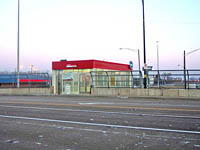
The north side auxiliary
entrance to 87th station, open just a few weeks, is seen
looking northwest on December 24, 2006. For a larger view,
click here.
(Photo by Graham
Garfield)
|
At 9am on Monday, December 11, 2006, the new auxiliary entrance to
87th station opened on north side of 87th Street. Similar to how 79th
station was modified about 25 years before, the north side entrance
allows passengers to access the station without crossing the wide and
busy 87th Street and provides an easier transfer to and from
westbound #87 87th buses. The entrance is a small enclosure housing
stairs and an escalator down to a platform-level passage which leads
to the fare controls and platform.
By the end of 2006, the renovation of 87th station
was substantially complete with only punchlist work remaining. The
finished station included the improvements listed above and, much
like the original Kennedy-Dan Ryan project design by Skidmore,
introduced several elements now standard at Dan Ryan stations (minus
95th/Dan Ryan and Cermak-Chinatown,
which were not part of the project) including a new type of Customer
Assistant booth (now also used in the renovated Brown
Line stations), windbreak, and combination bench/sandbox. The
station house and platform canopy received red bands as part of its
new paint scheme, providing some color to the facility's exterior as
well as line identification.
The main entrance on the south side of 87th Street
received a new white-painted steel "eyebrow canopy" over the front of
the station house to protect passengers waiting to transfer to
eastbound #87 87th buses. The canopy, a modern design somewhat
reminiscent of a scaled-down version of the crosswalk covering
installed at Sox-35th in 2002-03,
includes 10 art glass panels in its roofing. The red-tinted images
are of a PCC streetcar and the former streetcar terminal at
84th/State, three blocks north of the "L" station. The images are
installed at one of four different angles arranged randomly.
Also included as part of the graphics package were
station name signs mounted outside the tracks on the expressway
sidewall, facing the platform. These types of "outside" station name
signs were previous seen primarily at ADA-accessible stations,
although they were installed at all renovated Dan Ryan stations
including those without elevators, like 87th. The frames on which
these signs were mounted included a feature unseen before: a
stainless steel panel between the posts on the back of which was
mounted an extruded resin CTA logo facing the expressway. This was one of several ways the new (as
of 2004) CTA logo was
incorporated into the renovated Dan Ryan stations. The logo was also
mounted along the cornice of all the station houses (typically at the
rear end of the side elevation with with half of the shield extending
above the roofline) and was applied as a hanging station "identifier"
underneath the eyebrow canopy as the stations that received these
coverings.
Red Line South Reconstruction Project
In 2013, the CTA launched the Red Line South Reconstruction Project, a track renewal project to rebuild the Dan Ryan branch tracks from the bottom up, excavating down to the bottom of the trackbed to rebuild the underground drainage system then installing new ballast, ties, and tracks.
In order to perform the work more quickly and cost-effectively, the CTA closed the Dan Ryan branch for five months while work was performed. During that time, there was no 'L' service on the Dan Ryan branch south of Roosevelt station. Red Line trains were rerouted via the old 13th Street Incline from the State Street Subway to the South Side Elevated, where they operated to Ashland/63rd via the South Side Elevated tracks in a pattern reminiscent of the old Howard-Englewood "A" trains of the North-South Route days. Red Line service to Ashland/63rd began on Sunday, May 19, 2013. Following the five-month track reconstruction and renovation work on the Dan Ryan, Red Line service to 95th resumed at 4am, Sunday, October 20, 2013.
The five-month construction option saved $75 million over an option to perform work on weekends only. CTA invested that $75 million savings into station upgrades along the south Red Line, including lighting improvements, painting, new roofs and canopies at some stations, electrical substation work, and other improvements. In addition, elevators were added to the 87th, 63rd, and Garfield stations, making the whole Dan Ryan branch, and indeed all "L" stations on the whole South Side, accessible.
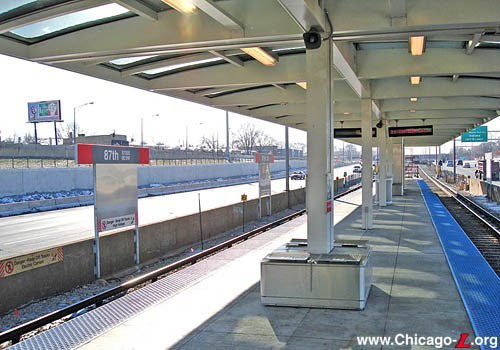
This view looking south on
the 87th station platform on December 8, 2006 shows several
elements from the station's renovation, including new
concrete flooring, refurbished canopy structure and new
skylight "bubbles", new signage, and new Dan Ryan-standard
stainless steel seating. For a larger view, click
here.
(Photo by Victor
Ramirez)
|
 87th Station
(1969-2003) |
Dan Ryan
Renovation (2004-present)
87th Station
(1969-2003) |
Dan Ryan
Renovation (2004-present)
87th Station
(1969-2003)
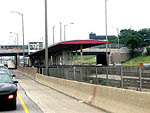
|
87th02.jpg
(127k)
The 87th station, looking north from the Dan Ryan Expressway
on July 28, 2001. (Photo by Graham
Garfield)
|
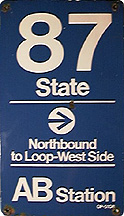
|
87thSign.jpg
(21k)
A 87th Street KDR-type station column sign.
(Sign from the collection of Graham
Garfield)
|
Dan Ryan
Renovation
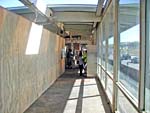
|
87th04.jpg
(159k)
To allow for the removal of the escalator from
street-level to the platform, a plywood wall was erected he
enclose the east half of the former fare control area at the
north end of the 87th platform. Looking south on September
1, 2005, the slightly-relocated fare controls are visible
beyond he plywood enclosure. (Photo by
Graham Garfield)
|
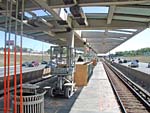
|
87th06.jpg
(198k)
In this September 1, 2005 view looking south on the
87th platform, the terrazzo flooring has been removed, as
have some of the plexiglas canopy "bubbles". The original
stainless steel windbreaks have also been removed. The
electrical conduits in the foreground, spray painted orange
to alert customers to potential hazards (as are other
elements in the station, such as the platform edge), were
originally on the panel of a windbreak. The plywood boxes
along the platform contain construction equipment and
materials. (Photo by Graham
Garfield)
|
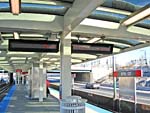
|
87th07.jpg
(183k)
The refurbished 87th platform is seen looking north
on December 8, 2006 with new flooring, signage, and Dan
Ryan-standard stainless steel windbreak. In the distance,
the new stainless steel "storefront" doors and windows can
be seen which now enclose the station house and protect it
from inclement weather. (Photo by Victor
Ramirez)
|

|
87th09.jpg
(161k)
A detail view of the art glass in the eyebrow canopy
over the street-level entrance on December 8, 2006, showing
red-tinted images of a PCC streetcar rotated at random
angles. (Photo by Victor Ramirez)
|
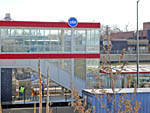
|
87th11.jpg
(179k)
The refurbished 87th station house, seen looking
through the tall weeds along the west frontage road of the
Dan Ryan Expressway on December 8, 2006, incorporated a
number of identification elements, including red banding to
aid in line identification and large
CTA logos mounted
along the cornice of the station house, with half of the
shield extending above the roofline. (Photo
by Victor Ramirez)
|
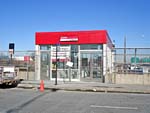
|
87th12.jpg
(157k)
The north auxiliary entrance to the 87th station is
nearing completion in this December 8, 2006 view looking
north. In three days, the chainlink fence would be removed
and customers would no longer have to cross wide, busy 87th
Street to enter the station from the north side of the
street. (Photo by Victor Ramirez)
|
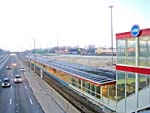
|
87th13.jpg
(150k)
This view of the renovated 87th station looking south
from the 87th Street bridge over the Dan Ryan Expressway on
December 8, 2006 shows several elements from the
rehabilitation project, including new canopy skylights, new
signage, and the refurbished, repainted station house and
canopy. (Photo by Victor Ramirez)
|
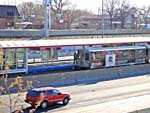
|
87th14.jpg
(201k)
The refurbished 87th platform is seen looking
southeast on December 8, 2006 as the Snickers-ad wrapped
cars 2605-06 leave the station. Visible improvements include
the new platform flooring, refurbished canopy with new
skylights, new signage including expressway-facing
CTA logos, and a
three-sided map/timetable pylon. (Photo by
Victor Ramirez)
|

|
87th15.jpg
(183k)
This view of the refurbished 87th platform looking
southeast on December 8, 2006 shows how the new wall-mounted
station name signs outside the tracks with their extruded
CTA logos repeating
along the back creates a strong
CTA identity along
the Dan Ryan Expressway. (Photo by Victor
Ramirez)
|
|

|

|



















